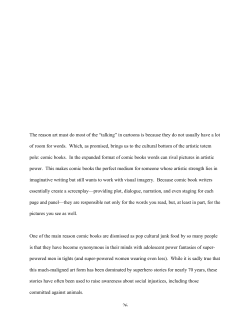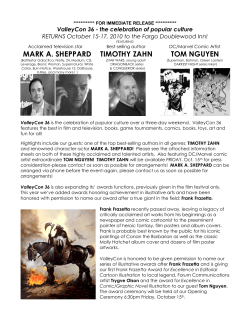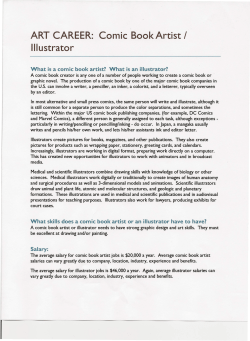
H
02-05_Jepson_Intro:a_chandler_kafka 9/15/2010 7:19 PM Page 2 S U N S T O N E Guest editor’s introduction HOW TO BECOME A MORMON-COMICS SNOB IN FIVE EASY STEPS By Theric Jepson H ELLO. I’M THERIC. IT’S 2010. AND I HAVE JUST (indirectly) had an appalling experience. My wife Lynsey was more disappointed than stunned recently when only four women showed up to our ward’s normally vigorous Relief Society book club in July. She was leading a discussion of Persepolis, Marjane Satrapi’s excellent memoir in comics. One woman was two hours late. One pre-announced no-show—who reads 300 books a year and would never just watch the movie instead—said she’d just watch the movie instead. To be fair (and because I know that bookgroup members Karen and Mindy and who-knowshow-many others subscribe to this magazine), our ward attendance at all meetings drops during the summer; but for me, who once eavesdropped jealously on this bookgroup’s incisive discussion of a YA novel, I am saddened to think that many of its literate and erudite members apparently saw Persepolis as only a silly picture book. Satrapi is recounting her child’s-eye view of the overthrow of the Shah’s regime! The Islamic Revolution! War with Iraq! Members of her family are kidnapped and executed! These are heady topics and Satrapi handles them with grace, aplomb, humor, and pain. Persepolis, in short, is great art. Breaking news: It’s 2010, and though not everyone has heard, the battle over whether comics are art is over.1 Fine-art museums across the country have been sponsoring comic-art shows, and comics have won or been shortlisted for most major book awards. A 2009 study from Simba Information, a market research and analysis group, found that one in ten adult bookbuyers buys THERIC JEPSON is an accidental Mormon-comics snob. He blogs at MOTLEYISION.ORG where vestiges of his snobdom first came to light. He is the editor of The Fob Bible, and his short fiction has appeared in Arkham Tales, Dialogue, and other venues. PAGE 2 comics. In other words, the English teacher at your local high school may be assigning comic books instead of burning them—where I teach, even history teachers assign comics. So if you’re one of the nine in ten who haven’t bought any comic books lately, consider owning this mag the first R in your repentance process. 2 Just last year—2009—the memoir-in-comics Stitches, by David Small, won even more than the 14 awards he lists on his website, including ALA award nominations, NPR Best Books, Publisher’s Weekly Top Ten, Amazon.com Ten Best Books, and accolades from the Washington Post, Los Angeles Times, and Barnes & Noble. I could name more if you’re still dwindling in Stitches unbelief. And 2009 offered plenty more work to convince the skeptical: from R. Crumb’s take on the book of Genesis,3 to Seth’s Babbit-esque George Sprott, to Logicomix— a dizzying biography of a mathematician. Or perhaps I could interest you in comics journalism—2009 saw the release of books on Katrina and Afghanistan. Or maybe noir murders are more your style? Or hilarious Canadian action? Run a Google search for best and comics and 2009 and see what you come up with. It was a good year. Maybe you’re wondering now why your university didn’t include Winsor McCay or George Herriman as part of that humanities survey you took freshman year. (Next time the alumni association sends you a letter asking for money, I suggest you ask them if your hard-earned dough will help fund a required course giving the kids a foundation in Famous Funnies—the first modern comic book, made of reprinted newspaper strips4—and Action Comics—the first superhero comic.) But fear not! I, Theric, am not here to kick sand in your face! In five easy steps, I can help you learn enough to not only understand the basics of comics generally, but to become your neighborhood’s first genuine Mormon-comics Snob. SEPTEMBER 2010 02-05_Jepson_Intro:a_chandler_kafka 9/15/2010 7:19 PM Page 3 S U N S T O N E STEP 1: COMICS AS ART S INCE MY GOAL is to make you a snob, I’m not going to spend any time convincing you of the validity of superhero comics or the Sunday funnies.5 Instead, we’re going to talk about “high-art” comics. To appreciate them properly, you need a grounding in theory. Or at least the capacity to fake a grounding in theory. And since we’re being snobs, let’s start with a current buzzword in academia: liminality. Hey, comics rock the liminal like no other art form! With comics—or sequential images—the gutter between panels is where the story actually takes place. Words and pictures are placeholders for story—the actual story unfolds within our brains.6 As our eyes jump across that little strip of white space between panels, our amazing brain dips into the liminal to construct a narrative linking the two panels. That’s how comics work. And if you can drop your fancy new vocab onto an unsuspecting dinner guest, he’ll have no choice but to agree with you. As Scott McCloud7 says, “in the world of comics, time and space are one and the same.”8 How is this accomplished? Through the liminal. Now, practice saying it in a mirror. Through the liminal. You’re looking snobbier already. STEP 2: KNOWING THE SCENE9 I F YOU’VE EVER been a snob in any field, you know there are concentric circles of snobbery. Populating the outer circle are those who know only about the excellence everyone else knows; but in the inner circle are those who know of the excellence so excellent that only they know it. I’ll give you some of both. Chris Ware’s Jimmy Corrigan is one of the most brilliant, complex, and depressing books of any sort I’ve ever read. In The Guardian, reviewer Phil Daoust calls it “a rare and uplifting example of an artistic vision pushed to the limits.” And Peter Schjeldahl, in the New Yorker, describes it as “the Is Marjane Satrapi’s Persepolis too “childish” for your ward’s Relief Society book club? SEPTEMBER 2010 Joseph Lambert’s Turtle, Keep it Steady! finds a brilliant way of representing music in visual form first formal masterpiece of [the] medium,” and while we can quibble about the word “first,” nothing else in that quotation is arguable. Anyone who, after reading Jimmy, still thinks comics cannot be great art is not worthy of comics and should just go read Philip Roth. Knowing about Jimmy Corrigan is step one in becoming a comics snob. You must read it. Then read it again, if your heart can handle it. It’s been about eight years since I last read it, and I still haven’t quite recovered. If you’re used to simple six-panel pages, you’ll be amazed at the complexity and precision of Ware’s pages. He throws around unique and ingenious layouts that can challenge the newcomer, but, should you need additional motivation to read his work, rest assured that reading Ware will encourage your brain to form new neural pathways, thus staving off dementia by up to five years for every hour spent reading. Guaranteed. Next, read Craig Thompson’s Blankets, the best younglove story in any medium since, I don’t know, Romeo and Juliet? Thompson’s beautiful, flowing lines are exactly how I wish I could draw. To be a proper snob, you must know that Art Spiegelman’s Maus took a Pulitzer. You must know that Gene Luen Yang’s American Born Chinese won the Printz and is the best immigrant story in recent memory.10 You also need to read some Will Eisner if you want to be taken seriously. Reading Kate Beaton’s hilarious historical webcomics and Jeff Lemire’s wrenching paper comics, and Seth’s (one name—like Madonna) cold hermetic retro-ish works will give a Canadian dimension to your snobbery. Try a few verbal jabs to put the other snobs off their game, PAGE 3 02-05_Jepson_Intro:a_chandler_kafka 9/15/2010 7:19 PM Page 4 S U N S obvious-but-unspoken facts like, “Daniel Clowes is overrated,” or “R. Crumb doesn’t suck nearly as much now that he’s an old man,” or “All Jason11 characters look the same.” Now that you’re familiar with some of the better-known names, it’s time to delve into the names of top-notch artists of whom lesser geeks remain ignorant. Try these partyfriendly phrases: “Tom Neely’s The Blot offers a master’s course in composition.” “Did you see Dan Zettwoch’s old church bulletins?” “Graham Annable’s Burden was the most startling exploration of sibling rivalry I’ve ever read.” “Joseph Lamber’s Turtle, Keep it Steady!—best musical comic ever?” “I’m not sure if Thomas Ott is inherently awesome or just German.” “Besides being too French for its own good, Nicolas de Crécy’s Glacial Period degenerated into clichés and moralizing.” Congratulations, you can now hold your own in any conversation.12 T O N E syndication in 1992. WERF: Um. Why not? YOU: Well (Sniff here.), as you know (Arch eyebrows here.), 1992 was a banner year for Mormons in comics. That’s the year Mike Allred started publishing Madman, and he went on to become the Warholian pop master of modern comics.14 It’s also the year James Owen started publishing Starchild,15 and you know how terrific that series is. And, perhaps most important, it’s the year Brad Teare’s Cypher arrived in book form. He has ten volumes worth of Cypher planned and (Lean in conspiratorially here.), I hear he’s started work on it again.16 That was also the year Shauna Mooney Kawasaki illustrated her first kids’ book.17 Would that she published comics more provocative than the ones she draws for The Friend!18 WERF: Uhhh. STEP 3: FAKING THE BASICS OF MORMON COMICS N OW THAT YOU’RE an expert in comics generally, you need to become an expert in Mormon comics. Just a few casually placed obscure-yet-earthshatteringly-important facts will be enough to confirm your expertise. Imagine with me: Having exhausted your knowledge, excuse yourself to get another gourmet organic root beer, leaving the impressionable WERF thinking that if you know this much about just one year, you must know everything about everything. Occam’s razor insists. STEP 4: NAVIGATING THIS ISSUE SCENE: Mormon-minded minglers mingle. YOU are approached by WERF13 who is holding a copy of the day’s paper. YOU see the comics peeking out, so YOU ask: YOU: Been reading the comics? WERF looks embarrassed. YOU: Did you know that the fellow who does Pickles is Mormon? WERF: Really? YOU: Sure. (Sigh here.) Shame he didn’t begin S UNSTONE, OF COURSE, has always published panel cartoons, from the greats like Pat Bagley and Cal Grondahl, and more recently Jeanette Atwood’s getting-better-every-month take on the Book of Mormon. So it’s natural that SUNSTONE should now present a smattering of what Mormon comics looks like today. The first thing to note is the breadth of style in these pages: So many Mormons making comics of so many different kinds! Look at Galen Dara’s earthy mysticism (page 60). Witness Nick Perkins’s bobble-headed National Treasure (page 84). Then ask yourself: How could they be more different? And this collection is just a smattering of what’s out there. Check out Elna Baker’s autobiographical comics on her website (ELNABAKER.COM). Thrill at the competition between Ryan Ottley and Ethan Van Sciver for Most Popular Superhero Artist du Jour. Jake Parker just released his first book, Missile Mouse, and his entry on page 55 just proves that he’ll only get bigger and better with each coming year. Howard Tayler gets Hugo nominations like his brother gets fleas.19 Speaking of getting bigger, Ethan’s brother Noah is looking like a strong contender for Indie Artist of the Coming Decade. And Joshua Smeaton? Alas, I only learned about him the day after submissions were due. He seems cool. Maybe next time, Joshua. Maybe next time.20 In an attempt to capture the meaning of life, the hero of Brad Teare’s Don’t worry about navigating this issue; just let it Cypher runs off the edge of a cliff. Ain’t that the way it always goes? flow. Skip around. Read what strikes you; then flip a PAGE 4 SEPTEMBER 2010 02-05_Jepson_Intro:a_chandler_kafka 9/15/2010 7:19 PM Page 5 S U N S T O N E will be your joy? Pretty dang great. And keep your eyes open as we move into the future. Dorothy Delgado is working on a book-length project about her experiences as a young widow; the Morrison brothers are also working on a larger project while Blair Sterrett has his fingers in about a million different projects. What else? Just watch—you’ll see. So read this issue. Share this issue. Then go forth and read some more. It’s a great big Mormon-comics world out there. NOTES Comics is going through a stage where it seems like every work needs to include some meta elements. David Small’s Stiches is no exception. few pages and read some more. Expect to be surprised. Be willing to read your favorites six or seven times—and the ones you hate twice as many times. STEP 5: ASK—WHAT DO YOU KNOW ABOUT MORMON COMICS? WOULD YOU LIKE TO KNOW MORE? C ONGRATULATIONS! I CAN already see some geeky muscles popping out on your brain. Feels good, doesn’t it? And things that feel good make us want to share them with those we love. So buy extra copies of this issue for your friends and family. Also, type some of the names from the table of contents into Google21 and joyfully learn that Kevin Beckstrom produces an online strip about Nephite family life (ZARAHEMLATIMES.COM), that Adam Koford has produced hundreds of gags with his oldtimey hobo cats (APELAD.BLOGSPOT.COM), that Patrick Scullin just got a Super Siblings book out, and that Brandon Dayton’s SUNSTONE entry is related to his Green Monk22 thing. Won’t that be exciting! Then you can send that info on to your friends and family too! And if your efforts bring just one soul into Mormon-comics snobdom, how great SEPTEMBER 2010 1. Like Japanese soldiers wandering out of the Philippine jungle. 2. The second R is read! 3. See a review on page 84. Though Crumb’s The Book of Genesis is often called “controversial,” I’m not really sure who’s supposed to be mad about it. Fact is, it may well be the best thing he’s ever done. Though maybe I should point out that I say this as someone who generally despises Crumb, even if he is widely considered a master of the form. 4. Actually, Yellow Kid strips were compiled into a book first, but that was long enough before Famous Funnies that they feel like a different phenomenon. 5. I am quick to point out, though, that examples of great artistry exist in both formats. Watchmen is the superhero comic with the reputation that just won’t stop and I’ve got bets down that Peanuts will survive as one of the most admired pieces of twentieth-century American art one hundred years from now. 6. Not to suggest that comics have to tell a story. They don’t. But I think comics are most powerful when used as a medium of narration, so that’s what we’re going to discuss. 7. Namedropping is important in being a snob. I hope you’re taking notes. 8. As long as we’re talking about Scott McCloud, I should mention that it’s no longer possible to be a serious student of comics without having read his Understanding Comics. It’s a treatise on comics in comics form. Just as it should be. 9. I’m talking U.S. and Canada here, primarily. Any mention of other artists will be purely accidental. 10. Or is that Shaun Tan’s The Arrival? They’re both so good I can’t choose. 11. Again, one name—like Madonna. 12. Just remember this snob trick when someone asks you about something you’ve never heard of before: Roll your eyes and say, “Oh. That.” You can get away with that about four times per conversation, which is generally ample. 13. To the best of my knowledge, the only gender-neutral pronoun to come out of BYU. 14. They’d better. Sheesh. Anyone who claims to know anything about Mormon comics but doesn’t know Mike Allred deserves a smack. The only time Mormon comics has become national news is when he quit some high-paying gigs to draw Book of Mormon comics. 15. While Starchild has long been Owen’s flagship, honestly he’s best known in the business not for his art or writing but for his rabid self-promotion. (Which I find remarkable since I made arrangements at the 2009 Comic-Con to interview him later, yet he’s never returned my emails. How does that qualify as rabid self-promotion?) 16. Don’t hold your breath. Teare’s mostly pursuing painting these days, but you can see his classy scratchboard-style monthly in The Friend. He has also done a lot of art for SUNSTONE and Dialogue. 17. I know picture books technically aren’t comics, but come on! It’s Shauna Mooney Kawasaki! 18. Kawasaki may be the most recognized artist in Mormon circles. Look her up. You’ll recognize her line quality immediately. 19. Joke! Love ya, Randy. 20. And, after finalizing this essay but before going to press, I learned that the new guy in my ward also draws the crowdsourced webcomic Midtoon. The smallness of our world only proves how dang big it is. 21. In a public, well traveled corner of your house, I presume. 22. Only five bucks at BRANDONDAYTON.COM! PAGE 5
© Copyright 2025














